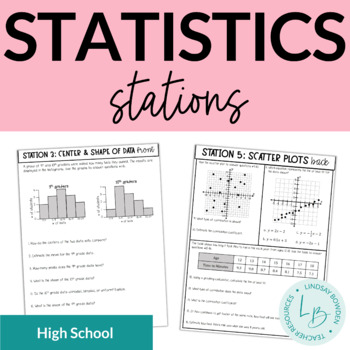Statistics Stations
Lindsay Bowden - Secondary Math
4.1k Followers
Grade Levels
8th - 10th, Homeschool
Subjects
Resource Type
Standards
CCSSHSS-ID.A.1
CCSSHSS-ID.A.2
CCSSHSS-ID.A.3
CCSSHSS-ID.A.4
CCSSHSS-ID.B.5
Formats Included
- PDF
Pages
10 + answer keys
Lindsay Bowden - Secondary Math
4.1k Followers
Also included in
- This is a complete statistics unit for an Algebra 1 course. All assessments (quizzes, study guide, and test) are editable to fit your needs. This unit is included in my Algebra 1 Curriculum.*Note: This unit is best suited for on-level or lower-level/special education math classes. Supplements will mPrice $49.00Original Price $49.00
Description
These statistics stations have 5 front and back stations that cover:
- histograms and dot plots
- two-way frequency tables
- center and shape of data (central tendency, peaks, symmetrical or skewed)
- spread of data (range, IQR, MAD)
- scatter plots (correlation, line of best fit, linear regression)
Includes a student answer sheet and answer keys!
Check out my YouTube video on stations here!
You may also like:
- Box and Whisker Plots Notes & Worksheets
- Histograms Notes & Worksheets
- Scatter Plots Notes and Worksheets
- Probability Stations
Terms of Use:
This product should only be used by the teacher who purchased it. This product is not to be shared with other teachers. Please buy the correct number of licenses if this is to be used by more than one teacher.
Did you know?
You can receive TPT store credits to use on future purchases by leaving feedback on products you buy! Just click on "My Purchases" under "Buy"!
Connect with me!
Total Pages
10 + answer keys
Answer Key
Included
Teaching Duration
1 hour
Last updated Feb 25th, 2020
Report this resource to TPT
Reported resources will be reviewed by our team. Report this resource to let us know if this resource violates TPT’s content guidelines.
Standards
to see state-specific standards (only available in the US).
CCSSHSS-ID.A.1
Represent data with plots on the real number line (dot plots, histograms, and box plots).
CCSSHSS-ID.A.2
Use statistics appropriate to the shape of the data distribution to compare center (median, mean) and spread (interquartile range, standard deviation) of two or more different data sets.
CCSSHSS-ID.A.3
Interpret differences in shape, center, and spread in the context of the data sets, accounting for possible effects of extreme data points (outliers).
CCSSHSS-ID.A.4
Use the mean and standard deviation of a data set to fit it to a normal distribution and to estimate population percentages. Recognize that there are data sets for which such a procedure is not appropriate. Use calculators, spreadsheets, and tables to estimate areas under the normal curve.
CCSSHSS-ID.B.5
Summarize categorical data for two categories in two-way frequency tables. Interpret relative frequencies in the context of the data (including joint, marginal, and conditional relative frequencies). Recognize possible associations and trends in the data.






